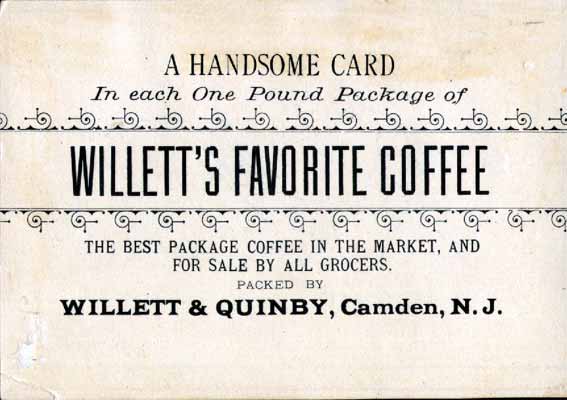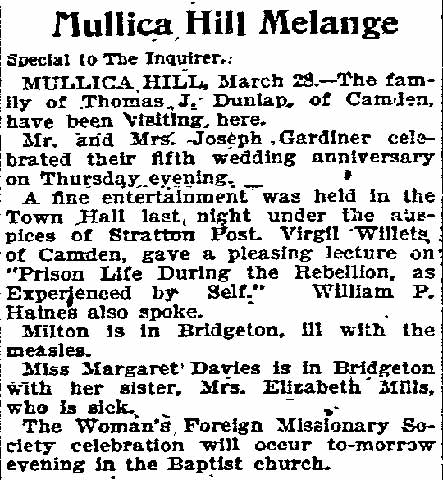|
The
Twelfth New Jersey Infantry Regiment was raised under the second call of
the president for 300,000 men, Robert C. Johnson, of Salem, formerly
major of the 4th regiment (3 months' men), being commissioned as its
colonel early in July, 1862.
Woodbury,
in Gloucester County, was selected as the rendezvous, and on July 25 the
first detachment of troops, about 950 men, was mustered into the U. S.
service. Many of the officers had already seen service in other
regiments, but comparatively few of the men were familiar with military
duties or requirements, though all entered cheerfully upon the work of
preparing for the duties before them.
On
September 7 the regiment left the state for Washington, but at Baltimore
was diverted from its course by General Wool, commanding that district,
who ordered it to proceed to Ellicott City, the county seat of Howard
County MD, 15 miles from Baltimore on the line of the Baltimore &
Ohio railroad.
At
Chancellorsville, on May 3, 1863, the regiment received its first taste
of actual warfare. It behaved with great gallantry, though the loss was
severe, amounting to 179 in killed, wounded and missing. Although under
arms during the two succeeding days and nights, it was not again
engaged, and on the night of the 5th it re-crossed the Rappahannock and
proceeded to its old camp, having in its first battle lost over
one-tenth of its men.
Soon
after reaching the field at Gettysburg on July 2, Company I was sent out
on the skirmish line, but the combat not yet being opened, only two or
three casualties were sustained. In the afternoon a house and barn
standing about 200 yards west of the Emmitsburg road and nearly
equidistant from either army having been occupied as a cover by the
Confederate sharpshooters, Companies B, H, E and G were sent out to
dislodge them, which they did, capturing 6 commissioned officers and 80
men, but with considerable loss, Captain Horsfall of Company E, a brave
officer, being killed, and Lieut. Eastwick wounded. During the fearful
infantry contest of the following day the regiment was actively engaged,
but only lost 5 or 6 men killed and 1 officer and 30 men
wounded.
On
October 14, 1863 when near Auburn mills, some 2 miles east of
Warrenton, the Confederate cavalry made an attack upon the corps of
which the regiment was a part, evidently hoping to capture its train,
but they were repulsed with loss and the corps continued its retreat
toward Centerville, the point which Lee was straining every nerve to
reach in advance of the Union troops. In the engagement at Bristoe
Station, which lasted for 3 or 4 hours, several men of the 12th were
wounded, Lieutenant Lowe, of Company G, being among the number. In the
skirmishes at Mine Run on November 28, 1863, the regiment did not
sustain any casualties, although under fire on several occasions. In the
affair at Morton's Ford, on February 6, 1864,some 10 men of the regiment
were wounded, but only 1 fatally.
From
May 4 through June 23, 1864, the Twelfth New Jersey was in battle on no
less than fifteen separate occasions. At the battle of the Wilderness,
although not engaged as a whole, the regiment suffered considerably,
Lieutenant John M. Fogg, of Company H, being killed, while Lieutenant
Frank M. Riley, of Company K, and several others were wounded. Two days
later the regiment lost heavily, Lieutenant Colonel Davis and Captains
Chew and Potter being among the wounded. In the magnificent assault at
Spottsylvania, which resulted in the capture of over 3,000 prisoners and
some 30 guns, the 12th again suffered severely, Lieutenant Colonel Davis
being instantly killed while bravely leading the regiment; Captain H. M.
Brooks and Lieutenant E. P. Phipps were severely wounded and were
obliged to quit the service in consequence. In the assault at Cold
Harbor the loss of the regiment was severe, Captain McCoomb, commanding
the regiment, being mortally wounded by the explosion of a shell, which
also killed or wounded several privates. Up to June 16 the total loss of
the regiment in this memorable campaign had been some 250 killed,
wounded or missing — a large proportion of the wounded being
officers.
From
this time forward the regiment was in position at various points on the
line, and in July it participated in the movement and affair at
Strawberry Plains and Deep Bottom, on the north side of the James.
Thence, by a forced march, it returned to the Petersburg front, arriving
in time to support the assault at the explosion of the mine, July 30,
though not actually engaged. It participated in the second movement to
Deep Bottom, charging the enemy's picket line under Captains. Chew and
Acton, and upon returning marched to the extreme left flank of the Army
of the Potomac, whence it was marched to Reams' station, on the Weldon
railroad, where the 1st division of the corps had preceded it. In the
severe action at the latter place Lieutenant Colonel Thompson,
commanding the regiment, was severely wounded and Lieutenants Rich and
Stratton were killed.
After
the action at Reams' station the regiment was in various positions along
the Petersburg front, Fort Hell on the Jerusalem plank road, Fort
Morton, and at other points, until late in October, when it moved out
and participated in the action known as the battle of the Boydton road,
where it lost 4 killed and 9 wounded--including Captain T. O. Slater. In
the winter of 1864-65 it took part in the various actions at Hatcher's
run, where in one instance it charged across the run, waist deep, and
took the enemy's works, upon which its color-bearer, Ellwood Griscom,
was the first to plant the national colors. It was present in the
movements of the army preceding the main assault on the Petersburg
defenses; took part in the assault, under the command of Major Chew, and
aided in the various actions during Lee's retreat until his surrender.
It returned, via Richmond, to Bailey's crossroads, in front of
Washington, where in June, 1865, the old battalion of the regiment was
mustered out of service, and in July the remainder of the regiment. Its
total strength was 1,899, and it lost, by resignation 14, by discharge
171, by promotion 56, by transfer 206, by death 261, by desertion 216,
by dismissal 3, not accounted for 29, mustered out, 943.
By
1870 Virgil Willett was living in Camden's North Ward with his wife
Leonora, son Joseph, and daughters Clara and Leonora G.“Gertie”
Willett. A son, also named Virgil, came shortly after the Census was
taken, but sadly, Joseph Willett would pass during the 1870s. Virgil
Willett listed his occupation as a “dealer in milk” in
1870.
At
some point during the 1870s Virgil Willett went into the business of
packaging coffee. He was still involved in this at the time of the 1880
Census, when he was living at 501 North 3rd Street. The coffee venture
had ended by early 1888, when he went into the grocery business in
Philadelphia. By 1887 he was living at 828 North 2nd Street in
North Camden, and was
there as late as 1890. He filed for his Civil War pension on September
4th of that year. Virgil Willett was also a member of the
Thomas M.K. Lee Post No. 5,
of the Grand Army of the Republic, in Camden. On occasion he traveled
about the area, speaking at G.A.R. events. He was active as a member of
Tabernacle
Methodist Episcopal Church.
Virgil
Willett passed away on January 16, 1899. He was survived by his wife,
Leonora Willett.
Virgil
Willett was a longtime member of New Jersey Lodge No. 1,
Independent Order of Odd
Fellows and of Camden Lodge, No. 1, Ancient Order of United
Workmen. George Reeser Prowell wrote the following in his History of
Camden County, New Jersey which was published in 1886:
Ancient
Order of United Workmen.
The
object of this order is to embrace and give equal protection to
all classes and kinds of labor, mental and physical; to strive
earnestly to improve the moral, intellectual and social
condition of its members; to create a fund for the benefit of
its members during sickness or other disability, and, in case of
death, to pay a stipulated sum for each member, thus
guaranteeing his family against want. Its jurisdictions are a
Supreme Lodge, Grand and Subordinate Lodges. The Grand Lodge of
Maryland, New Jersey and Delaware is thus officered: G. M. W.,
John J. Gallagher, of Wilmington, Del.; G. F., William H.
Vermilye, Jersey City, N. J.; G. O., James A. Vansant, Camden,
N. J.; G. G., John W. Diefendorf, Wilmington, Delaware; G. R.,
A. F. Colbert, Baltimore; G. Receiver, Myer Hirsch, Baltimore;
G. M. E., G. S. Wilkins, M.D., Baltimore.
Camden Lodge, No. 1. was chartered
January 27, 1879, with these officers : Master Workman, Joseph
R. Leaming; Foreman, Charles Markley; Overseer, George W. Coles;
Recorder, Harry Ladow; Financier, William Thegen; Receiver,
Albert P. Brown; Guide, William P. Partenheimer; Inside
Watchman, Benjamin M. Denny; Outside Watchman, William Jones;
Medical Examiner, H.
Genet Taylor, M.D. These were also charter members,
Moore Beideman, Robert L. Barber, John F. Benner, De Witt C.
France, Joel H. Evaul, Henry S. Fortiner, George R. Fortiner,
Howard L. Gandy, Merritt Horner, William Struthers, Benjamin G.
Smith, William H. Stansbury, Marmaduke B. Taylor, Frank S.
Wells, John S. Wells. The lodge has one hundred and forty-eight
members, with these officers: Past Master Workman,
J. C.
Prickett; Master Workman,
Virgil
Willett; Foreman, J. H. Le Chard; Overseer, R. R.
Lewellen; Receiver, W. R. Lun drum; Financial Secretary, Charles
Markley; Recording Secretary, John Woltjen; Guide, J. S. Pike;
Inside Watchman, John W. Clopper, Jr.; Outside Watchman, J. H.
Evaul; Medical Examiner, E. R. Smiley, M.D.
|


